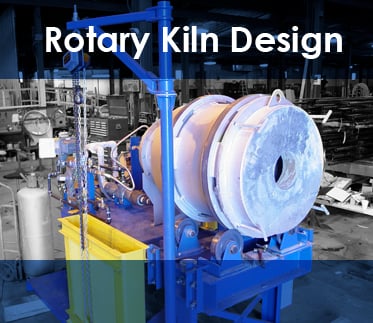The rotary kiln, sometimes also referred to as a calciner, is a highly engineered thermal processing device. Unlike rotary dryers, which serve to reduce the moisture content in a given bulk solid, rotary kilns are intended to cause a physical change or chemical reaction in a material, and subsequently, operate at much higher temperatures.
Rotary kilns can be used to cause a variety of reactions in a material, from thermal decomposition and volatilization of organic compounds, to oxidation or the removal of chemically bound water – among many other possibilities. Their high level of flexibility and customization sees their use in nearly every industry, and the applications in which they can be used continue to grow.
While the flexibility of the rotary kiln lends it to use in an array of applications, every material behaves differently in a kiln. This requires that each rotary kiln is custom designed around its specific application and the unique requirements presented by the material.
A variety of material characteristics will play a part in how the material at hand will perform in the kiln, and subsequently, how the kiln will need to be designed in order to reach the intended objective. If a material contains surface moisture that will need to be removed before the reaction, one consideration that must be addressed at the outset of design is how that moisture will be removed.
Moisture Removal
Moisture removal can occur in the kiln, but it is secondary to the primary objective and is significantly less efficient than what could be done in a rotary dryer.
The need to remove moisture prior to the reaction then presents a choice: use the rotary kiln to reduce the moisture, or add a rotary dryer into the process before the kiln. There are costs and benefits to each approach.
Using the Rotary Kiln for Moisture Reduction
Unlike rotary dryers in which material is showered through the products of combustion, material in a rotary kiln tumbles along the interior of the drum, resulting in a much lower rate of heat transfer between the material and the process gas. As a result, drying material in a rotary kiln takes much longer than if it were to be processed in a rotary dryer and is much less efficient. Drying time would be substantially further increased if the kiln being utilized was of the indirect-fired design, where products of combustion and the material are kept completely separate and material is heated through contact with the drum shell.
The advantage to this approach, however, is that an additional device and its support equipment need not be purchased.
Employing a Rotary Dryer
The alternative to drying material in a rotary kiln is to add a rotary dryer into the process prior to the material going into the rotary kiln. Taking this approach would efficiently dry the material before it enters the rotary kiln, leaving the rotary kiln the sole job of converting the material.
With a rotary dryer, flights lift the material and drop it through the stream of hot gas, creating a showering effect called a curtain. This showering effect allows for maximum heat transfer between the material and the gas, drying the material in an efficient manner.
In this situation, the rotary kiln could then be shorter. The down side to this method would be that an additional piece of equipment would be required.
Conclusion
FEECO is a leader in custom rotary dryers and kilns. We engineer our equipment around the characteristics of the material to be processed for an optimal processing solution. The FEECO Innovation Center offers a variety of batch- and pilot-scale kilns to carry out comprehensive testing programs and gather the process data necessary for scale up to make informed decisions in the design process. For more information on our thermal processing capabilities, contact us today!



